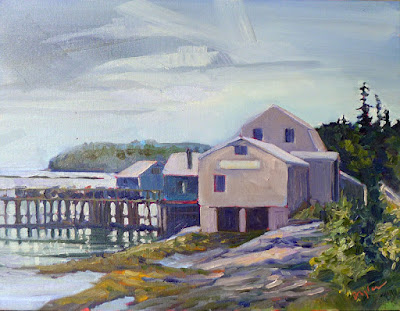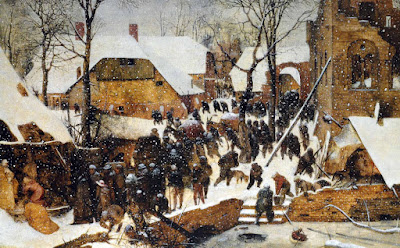Do all plein air artists work in this frenzied way? Only if they want to make a living.
| Full stop, by Carol L. Douglas (sold). |
I received a number of reader responses to my recent post, How long did Van Gogh take to complete a painting? They came by email, because Blogger’s comment feature is a little wonky right now. Some comments are going through, but if you have trouble, just email me here.
“Are these events increasing the market for art?” wrote S, who is a statistician in real life. That’s a question I can’t answer, because it’s too small a market niche for the government to monitor. The Bureau of Labor Statistics identifies only 11,000 people in the category of Individual Fine Artist. (I’m not sure it’s true, since I know at least 11,000 artists personally.)
| Headlamps, by Carol L. Douglas (available, and a favorite painting of the artist). |
That compares to a global art market in the $60 billion range, depending on whom you ask. This is concentrated in the US, and 70% are paintings, almost all by dead people. Researchers are understandably more interested in that lucrative aftermarket than in the art that is being created now.
I can only note that there are more plein air events every year, which is a sign that they work.
 |
| Lobster pound at Tenant’s Harbor, by Carol L. Douglas (available through the Kelpie Gallery). |
“You lump all plein air painters into this frenzied bunch,” wrote C. “Perhaps your view is informed by the competitive way you’ve decided to paint. I find it hard to believe that everyone works this way. Or is it only the non-professionals like me who take it slow?”
Professional plein air painters work in this circuit, and I’m typical, I think. None of the other 49 painters at Adirondack Plein Air, for example, had any problems completing a finished, lovely work in the two hours allotted for our Quick-Draw. I’ve observed that artists tend to produce around one-two paintings a day at these events, depending on the size. That puts them square in the 3-5 hour range per painting.
They cost so much because there’s a lot of other work and expense involved, and because the longer the artist’s sales record, the more his or her work is worth. In comparison, nobody ever asks how long their Nike Lebron Xsneakers took to make. It was probably just a few minutes.
 |
| Bahama Palm, by Carol L. Douglas (available). So far I haven’t been able to successfully monetize my southern journeys. That would extend the season. |
“Do you like being able to do a mix of plein air and studio work?” asked S. “How many months in a year are dedicated to plein air events? Or is this the wrong metric?”
In fact, it’s an important question, one we ask ourselves at the end of every season. What is a sustainable level for plein air events?
Studio painting is the normal place to finish commissions or larger, more involved work. Currently, I’m doing events only from June through September, but I hope to spread them out more across the year. However, the farther I travel, the higher my expenses become.
The answer is highly individual, and it changes over time. In fact, I was planning to have coffee with Stephan Giannini this morning to discuss this exact question, but I forgot I’m supposed to be in Buffalo. We’ll take it up again in October, which is the next time we’ll both be home.




